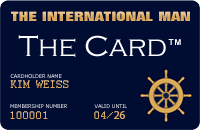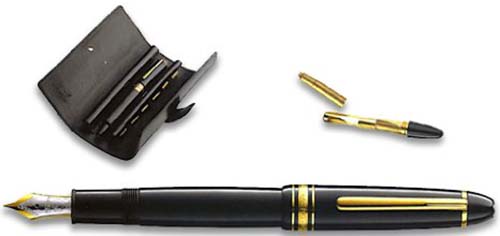Top 125 Best Fountain Pens and Writing Instruments
"We used pencils when we were small. But now we use pens ... Do you know why? Because mistakes in childhood can be erased, but not now." - Warren Buffett.
A FOUNTAIN PEN is a nib pen that, unlike its predecessor the dip pen, contains an internal reservoir of water-based liquid ink. From the reservoir, the ink is drawn through a feed to the nib and then to the paper via a combination of gravity and capillary action. As a result, the typical fountain pen requires little or no pressure to write.
The earliest historical record of a reservoir pen dates back to the 10th century. In 953, Ma'a-d al-Mu'izz, the caliph of Egypt, demanded a pen which would not stain his hands or clothes, and was provided with a pen which held ink in a reservoir and delivered it to the nib, and could be held upside-down without leaking.
Progress in developing a reliable pen was slow, however, until the mid-19th century. That slow pace of progress was due to a very imperfect understanding of the role that air pressure played in the operation of the pens and because most inks were highly corrosive and full of sedimentary inclusions. The Romanian inventor Petrache Poenaru received a French patent for the invention of the first fountain pen with a replaceable ink cartridge on May 25, 1827. Starting in the 1850s there was a steadily accelerating stream of fountain pen patents and pens in production. It was only after three key inventions were in place, however, that the fountain pen became a widely popular writing instrument. Those inventions were the iridium-tipped gold nib, hard rubber, and free-flowing ink. The first fountain pens making use of all these key ingredients appeared in the 1850s. It was in the 1880s that the era of the mass-produced fountain pen finally began.
At this time fountain pens were almost all filled by unscrewing a portion of the hollow barrel or holder and inserting the ink by means of an eyedropper. This was a slow and messy procedure. Additionally, fountain pens tended to leak inside their caps and at the joint where the barrel opened for filling. Now that the materials problems had been overcome and the flow of ink while writing had been regulated, the next problems to be solved were the creation of a simple, convenient self-filler and the problem of leakage. Self-fillers began to come into their own around the turn of the century; the most successful of these was probably the Conklin crescent-filler, followed by A. A. Waterman's twist-filler. The tipping point, however, was the runaway success of Walter A. Sheaffer's lever-filler, introduced in 1912, paralleled by Parker's roughly contemporary button-filler.
During the 1940s and 1950s, fountain pens retained their dominance: early ballpoint pens were expensive, prone to leaks and had irregular inkflow, while the fountain pen continued to benefit from the combination of mass production and craftsmanship. By the 1960s, refinements in ballpoint pen production gradually ensured its dominance over the fountain pen for casual use.
A BALLPOINT PEN is a writing instrument with an internal ink reservoir and a sphere for a point. The internal chamber is filled with a viscous ink that is dispensed at its tip during use by the rolling action of a small sphere. The sphere, usually 0.7 mm to 1.2 mm in diameter, may be made of brass, steel, tungsten carbide, or any durable, hard (nondeformable) material.
The manufacture of economical, reliable ballpoint pens arose from experimentation, modern chemistry, and the precision manufacturing capabilities of 20th century technology. Many patents worldwide are testaments to failed attempts at making these pens commercially viable and widely available. The ballpoint pen went through several failures in design throughout its early stages. It has even been argued that a design by Galileo Galilei (during the 17th century), was that of a ballpoint pen. The first patent on a ballpoint pen was issued on 30 October 1888, to John Loud.
ROLLERBALL PENS are pens which use ball point writing mechanisms with water-based liquid or gelled ink, as opposed to the oil-based viscous inks found in ballpoint pens. These less viscous inks, which tend to saturate more deeply and more widely into paper than other types of ink, give roller ball pens their distinctive writing qualities. The writing point is a tiny ball, usually 0.5 or 0.7 mm in diameter, that transfers the ink from the reservoir onto the paper as the pen moves.
A PENCIL is a writing implement or art medium constructed of a narrow, solid pigment core inside a protective casing which prevents the core from being broken and/or from leaving marks on the user’s hand during use.
Writing Instrument News, Reviews & Resources
- 7 Sensibly Priced Fountain Pens - Wired.
- 10 BEST JAPANESE STATIONERY DESIGNS TO ACHIEVE PEAK PRODUCTIVITY - "In an age where digital dominates our daily interactions, the tactile allure of Japanese stationery offers a refreshing pause. These meticulously crafted tools invite us to slow down, savor the art of writing, and elevate our everyday routines. Known for their precision and artistry, Japanese stationery designs blend tradition with innovation, transforming simple tasks into moments of mindfulness and creativity."
- 100 years of Montblanc's biggest icon: the MeisterstÜck - "This year, Montblanc is celebrating one-hundred-years of its most iconic creation, the Meisterstück range, a flagship line of pens so sought after, revered, and collected that it has become a piece of history in its own right."
- a Beginner's Guide to Pens - "For watches, we have the option for quartz and mechanical movements, as well as a number of hybrid and exotic options. And for pens, there are three broad categories which encompass the majority of writing utensils on the market: rollerball, ballpoint, and fountain pen."
- An Ode to the Pilot G2, the Greatest Pen on the Planet - "There are nicer pens and cheaper ones, too. But none are as noteworthy as Pilot’s retractable rollerball."
- Ancient objects that reveal writing's roots - "An exhibition about Iran traces how some of the world's earliest scripts developed. They were as much about images as text."
- AUTOPEN - "The Autopen is the oldest, most commonly used signing machine. It has been used by universities, government agencies, and other institutions for more than 60 years. The Autopen machines provide high quality signature replication with any common pen, pencil, or marker."
- AUTOPEN: Trump Says Biden’s Pardons are ‘Void’ & ‘Vacant’ Because of Autopen - "The use of the autopen, a device that reproduces signatures and is ubiquitous in government and business, is ordinarily uncontroversial. There is no power to undo a pardon in the Constitution or case law."
- BALLPOINT PEN - Wikipedia.
- BALLPOINT VS ROLLERBALL - "What is the difference between ballpoint and rollerball pens?"
- best pen 2023 - "After evaluating 26 contenders and conducting three rounds of testing, our experts found one clear winner."
- best pens for festive gifting - The Telegraph.
- Best Writing Pens, According to Authors, Artists & Other Creatives - "For note-taking, journaling or as gifts, enjoy the power of these pens."
- Bob Dylan apologizes for using autopen device to 'hand-sign' new book - "Bob Dylan has apologized for an 'error in judgment,' after it emerged that he used a machine to autograph special copies of his new book that had been advertised as 'hand-signed.'"
- Breguet Debuts a New Collection of Fine Pens Inspired by Its Watches - "Writing implements that practically beg you to whip out the fine stationary."
 - Cabinet d’Ecriture - Louis Vuitton Saint-Germain des Près, 6 Place Saint-Germain des Près, 75006 Paris, France.
 - Caran d'Ache Matterhorn Brut RosÉ collector’s edition - Limited Matterhorn Edition (4478 copies).
- Caran d'Ache revives the pencil sharpener - The Telegraph.
- CONWAY STEWART - luxurious leather pen cases.
 - DAMILIC - "The World Leader in Handwriting Automation." Automatic signing machines: Autopen, Signacript and Signature Systems (simulated handwriting software). Read also: Obama's signature: Is it real or is it autopenned?.
- FELT-TIP PEN - Wikipedia.
- FOUNTAIN PEN - Wikipedia.
- FOUNTAIN PEN DAY - Taking place on the first Friday in November each year, Fountain Pen Day is celebrated by enthusiasts worldwide as a time to embrace, promote, and share the use of fountain pens.
- From Da Vinci to Churchill: What our doodles can mean - "As a new exhibition shows, doodles can be a powerful form of creative expression."
- Generation Z is losing a skill we’ve had for 5,500 years: 40% are losing mastery of communication - "Is Generation Z losing touch with handwriting? A shocking 40% struggle with this vital skill, risking their cognitive development and personal connections. Discover what’s at stake for future communication and the steps to bridge this gap. A recent study from the University of Stavanger has found something pretty alarming: around 40% of Gen Zers are losing their grip on handwritten communication, a skill that's been key to human interaction for about 5500 years."
- Guide to Choosing a Felt Tip Marker Pen - JetPens.com.
- Hand you write with can determine how you vote, scientists find - The Telegraph.
- Have we all underrated the humble pencil? - "When the great 19th Century American writer Henry David Thoreau made a comprehensive list of supplies for an excursion, he specified obvious items like a tent and matches, and added string, old newspapers, a tape measure and a magnifying glass."
 - Herbin Wood Rocker Blotter - since 1837. Desk Ink Blotter - Included a Pre-Cut Blotter Paper.
- HOW TO USE A TACTICAL PEN: DEFINITION, TECHNIQUES & FACTS - Survival Mastery.
- List of pen types, brands and companies - Wikipedia.
- Louis Vuitton’s Cabinet d’Ecriture (Writing Cabinet) pop up store in Paris - LuxuryLaunches.
- LUZZO BESPOKE - writing box. Machined and polished aluminium frame with leather trim. Leather trimmed interior with storage pockets for envelopes, paper and pens.
- Maki-e - Japanese lacquer sprinkled with gold or silver powder as a decoration using a makizutsu or a kebo brush.
- MARKER PEN - Wikipedia.
- Mechanical pencil - Wikipedia.
- Meet the Nigerian artist illustrating the human experience with a ballpoint pen - "From a distance, Jacqueline Suowari's larger-than-life portraits look like monochromatic photographs overlaid with colorful graphics. Upon closer inspection, you see these dramatic images are the culmination of thousands of tiny lines made using a simple ballpoint pen."
- Moleskine’s latest smart pen saves your writing to download later - engadget.
- MONTBLANC & FERARRI REIMAGINE THE DAYTONA SP3 AS A LUXURY PEN - "Wrapped in sleek titanium (a rare moment for Montblanc utensils), the Stilema boasts a sleek look accompanied by clean, flexuous lines like the Daytona SP3."
- Montblanc celebrates its 110-year anniversary with a snake-charming new range - The Telegraph.
- Montblanc celebrates The Bard's birthday with a striking new pen - The Telegraph.
- Montblanc Enlists Spike Lee To Help Rewrite The Meaning Of Success - Forbes.
- Montblanc Finds Its Latest Muse: Elizabeth Taylor - "Montblanc has chosen another unforgettable woman as the focus of its latest Muses Special Edition pen collection: award-winning film star, influencer and activist Elizabeth Taylor (1932-2011). She is in good company. Former Montblanc muses have included Marilyn Monroe, Princess Grace of Monaco, Ingrid Bergman, Marlene Dietrich and Greta Garbo."
- Montblanc: Selection of the Perfect Nib - "To offer the perfect nib for each individual handwriting, Montblanc offers an exclusive selection of eight different nib widths. Choosing the right nib to match your personal writing style will allow you to write effortlessly."
- Montblanc WRITING INSTRUMENT REFILLS - 121 products.
- Montblanc’s Latest Great Characters Edition Pen Honors Elvis Presley - Forbes.
- Montblanc’s MeisterstÜck Fountain Pen Is a Masterpiece - "What's more, it's currently celebrating 100 years at the summit of luxury. Distinctively chunky and cigar-shaped, with a smooth body of black resin edged in precious metal, it is technically not 'a Montblanc' but a Meisterstück - 'masterpiece' in German."
- Neuroscience Says 1 Simple Habit Boosts Brain Connectivity, Learning & Memory - "Recent neuroscience research helps explain why, when it comes to learning and remembering, writing by hand is better than typing with a keyboard."
- Pelosi's 32 pens - "Impeachment trial: Why did Pelosi use so many pens? This is actually a long-standing US tradition - since President Franklin Roosevelt, presidents have frequently used multiple pens to sign high-profile pieces of legislation, so they can be offered as souvenirs and historical keepsakes."
- PEN - Wikipedia.
- PEN WORLD MAGAZINE
- PENCIL - Wikipedia.
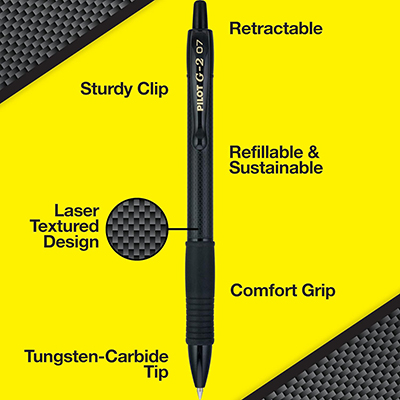 - PILOT - since 1918. "Power to the Pen!" All models.
- Pilot G2, the Greatest Pen on the Planet - "There are nicer pens and cheaper ones, too. But none are as noteworthy as Pilot’s retractable rollerball."
- Richard Mille Made a $105,000 Mechanical Fountain Pen - Bloomberg.
- ROLLERBALL PEN - Wikipedia.
- Rollerball vs. Ballpoint Pens - Pen Haven.
- Sign of the times: how the signature became a meaningless scrawl - "Written signatures will soon be redundant even for legal documents, the Law Commission says. Does anyone care?"
- SIGNASCRIPT - Signastript signing machines.
- STYLOPHILES ONLINE MAGAZINE
- STYLOS-LUXE.COM
- STYLUS MAGAZINE
- THE BEST PEN - Reviews by Wirecutter.
- The 'blackest' black: How a color controversy sparked a years-long art feud - "For decades, the idea that somebody can 'own' a color has been a contentious one."
- The cheap pen that changed writing forever - "Fountain pens were a stylish statement but messy and impractical. Their replacement was a stroke of design genus perfectly in time for the era of mass production."
- The clever folds to keep letters secret - "Hundreds of years ago, people developed ingenious methods to secure their letters from prying eyes - and they did it with only paper, adhesive and folds."
- THE FOUNTAIN PEN NETWORK Forums - since 2008.
- The Pen Is Mightier Than the Keyboard - "Advantages of Longhand Over Laptop Note Taking."
- This Pen Is Totally Over-Engineered. We Dig It Anyway - Wired.
- THIS FOUNTAIN PEN MAKES CREATION FLOW ON THE WRITING SURFACE, COMES WITH TURBO INK FILLING MECHANISM - "If you also love keeping a fountain pen handy, the Submarine Collection by TaG will interest you. The submarine-shaped fountain pen edition is developed in collaboration with Hou Xin-Yong, a highly experienced calligrapher with over 2 decades of expertise, and Lee Tai-Ying, the founder of a fountain pen club in Taiwan."
- Uni-ball Jetstream is the best pen for everyday writing - The Wirecutter.
- VENLO COMPANY - luxury pen cases.
- Virtual Visit: Switzerland’s Colorful Caran D’Ache - "Since overseas travel may not be on your list of things-to-do in the short term, join me for 'armchair visits' to fine pen manufacturers worldwide."
- What’s The Best Tactical Pen For 2016? - The Tactical Guru.
- Why we're seeing a letter-writing boom in lockdown - "Letter-writing: Connection in disconnected times. 'This Zoom stuff doesn't cut it.'"
Desk Pen Sets & Holders
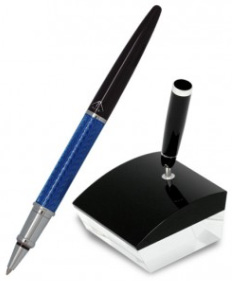 - ACME DESK PENS
 - Cartier Collection
 - Cross Classic Century Collection - Double Desk Set Walnut Finish With 10K Gold Plated appointments.
- DELTA DOLCEVITA DESK SETS
- El Casco Pen Tray 23k Gold
 - Ferrari da Varese Labrador Polished Sterling Silver Pen Desk Set
- Fjader Ballpoint Pen With Stand Chrome
- HOWARD MILLER - rosewood desk set with round clock.
- JAC ZAGOORY DESIGN - pen holders.
- MAGNO DESKTOP SET
 - MARLEN - leather deskset with: Class pen (black), knife for paper, desk-folio, paper pouche, envelopes-pouche, pens pouches.
 - MINIMALUX - pen pot.
 - MINIMALUX - pen rest.
 - Monocle - pen pot.
- PIANKI - luxury executive desk pen sets.
- pierluigi ghianda - pencil holder.
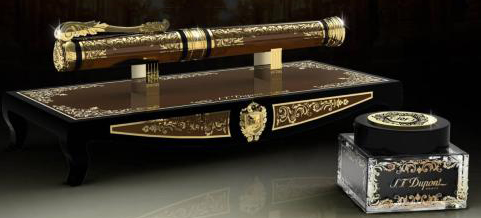 - S.T. DUPONT - pen desk set.
 - The Bridge - "Firenze 1969." Pen holder.
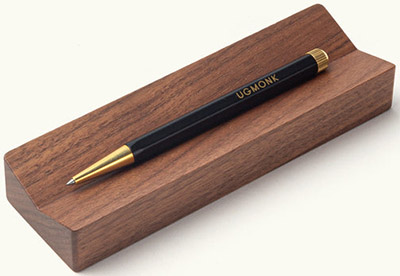 - Ugmonk - since 2008. "Ugmonk was founded by designer Jeff Sheldon with a mission is to produce well-designed objects with a minimal aesthetic."
Top 125 High-End Writing Instruments: A-Z
A
B
C
D
E
F
G
H
I
J
K
L
M
N
O
P
Q
R
S
T
U
V
W
X
Y
Z
- A -
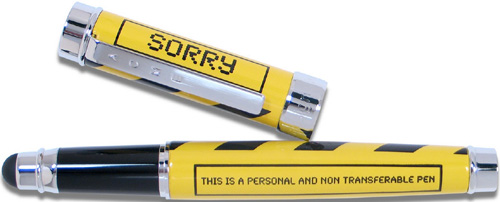 - ACME STUDIO - all models.
 - Adonit Jot Script 2 - Evernote Edition Fine Point Precision Stylus - for iPad, iPad Air, iPad Mini & iPhone by Adonit. "The first true fine point stylus that allows your handwriting to flow as freely as your thoughts. The new Jot Script makes it even simpler to take notes on the iPad, with a slimmer build, rechargeable battery, and improved precision and app integration."
 - AIRBUS - all models.
 - ALFRED DUNHILL - all models.
- Allen Edmunds - all models.
 - ALVIERI MARTINI - 1st Classe collection.
 - ANCORA - since 1919. "Perfection that Defies Time." All collections.
 - AP LIMITED EDITIONS - "Our limited edition pens will honor your family of heirlooms for years to come."
 - ASPINAL OF LONDON - men's silver pens.
 - ASPREY - "British Luxury Goods Since 1781." Silver pen.
 - Atelier Swarovski - since 2007. "Crystal rulers and pens to enrich your work space with form and function."
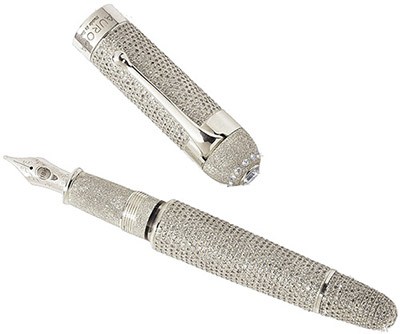 - AURORA - since 1919. All collections.
A
B
C
D
E
F
G
H
I
J
K
L
M
N
O
P
Q
R
S
T
U
V
W
X
Y
Z
- B -
 - BENTLEY - "Tibaldi for Bentley Limited Edition."
 - BIC PENS - all models.
 - Blackwing Pencils - "It's not just a pencil, it's an experience." Some of the world’s most legendary Grammy, Emmy, Pulitzer and Academy Award winners have created with Blackwing pencils.
 - BMW - writing utensils.
 - BREGUET - since 1775. All collections.
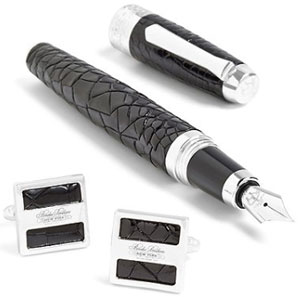 - BROOKS BROTHERS
 - Bruynzeel - "A range of high-quality pencils for artists, designers, illustrators and hobbyists with which to draw, sketch & colour."
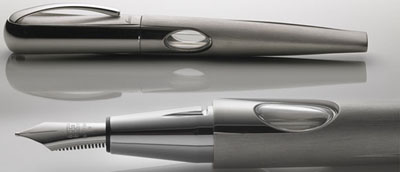 - BUGATTI LIMITED EDITION - by Ferrari da Varese. 499 pieces.
 - BVLGARI - ballpoint pen.
A
B
C
D
E
F
G
H
I
J
K
L
M
N
O
P
Q
R
S
T
U
V
W
X
Y
Z
- C -
- CALLIGRAPHY PENS - dip pens & nibs.
- CARAN D'ACHE - Founded in 1915 in Geneva, Switzerland. "For the pleasure of writing and drawing." All collections.
- Cartier Collection - "Historic and Exceptional Pieces from the Maison Cartier." All collections.
 - CHARRIOL - since 1983. All models.
 - CHOPARD - since 1860. All collections.
 - CONKLIN PEN CO. - since 1898. "The legendary name for writing instruments."
- CONWAY STEWART - "Bespoke British Luxury Pens Since 1905."
 - CROSS - founded in 1846. All models.
A
B
C
D
E
F
G
H
I
J
K
L
M
N
O
P
Q
R
S
T
U
V
W
X
Y
Z
- D -
 - DANITRIO - "Original Works for Original People."
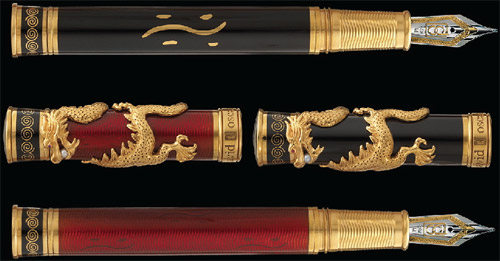 - DAVID OSCARSON - "From Generation to Generation..."
 - DAVIDOFF - all collections.
 - DELTA - "Made in Italy 1982."
 - Diplomat - since 1922. "Points of Distinction."
 - DISNEY - pens. All models.
 - DOUGLAS PELL - since 1972. "Quality Silver Products or Handmade Silver Products."
 - DRAGON PEN - Bruce Lee Dragon gold fountain pen by Montegrappa. Limited edition: 88 pieces.
 - DUKE - "The Duke Way, The Write Way."
 - DUNHILL - all models.
A
B
C
D
E
F
G
H
I
J
K
L
M
N
O
P
Q
R
S
T
U
V
W
X
Y
Z
- E -
 - ECHO SMARTPEN - equipped with a removable ball-point ink cartridge, a microphone to record audio, a speaker for playback, a small OLED display, and internal flash memory that captures handwritten notes, audio and drawings.
Livescribe 8 GB Echo Smartpen: $309.98
 - Amazon.com. - Amazon.com.
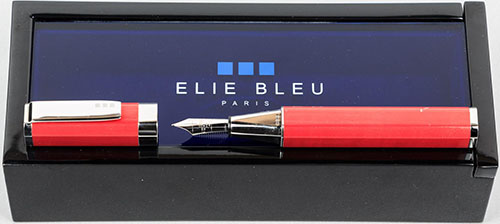 - ELIE BLEU Paris - since 1976. Fountain pens & roller balls.
A
B
C
D
E
F
G
H
I
J
K
L
M
N
O
P
Q
R
S
T
U
V
W
X
Y
Z
- F -
 - FABER-CASTELL - since 1761. All models.
 - FARBOD BARSUM - executive pen.
 - FEDERICO BUCCELLATI - since 1919.
 - FERRARI DA VARESE - Italian Fine Writing Intruments. All models.
 - FILOFAX - since 1921. Ballpens & pencils.

- Fisher space pens - since 1953. "Makers of the Original Astronaut Pen, among many other high quality writing instruments."
 - FJÄDER PENS OF SWEDEN - "These are a stylish desk pen that would grace any desk and would make the perfect present for someone looking for an unusual gift that cannot be found on the high street."
 - FOLLI FOLLIE - all models.
 - FORZIERI - since 1999. All models.
 - FRANKLIN-CHRISTOPH - since 1901. All models.
 - FREYWILLE - since 1951. "Pure Art." All models.
A
B
C
D
E
F
G
H
I
J
K
L
M
N
O
P
Q
R
S
T
U
V
W
X
Y
Z
- G -
 - Georg Jensen - "Elegant Scandinavian simplicity with a nod to traditional craftsmanship." Ballpoint, fountain & roller pens.
 - GIORGIO ARMANI PENS - Regal Collection.
 - GIRARD PERREGAUX - since 1791.
- GRAF VON FABER-CASTELL - since 1761. "Passion and Precision." All models.
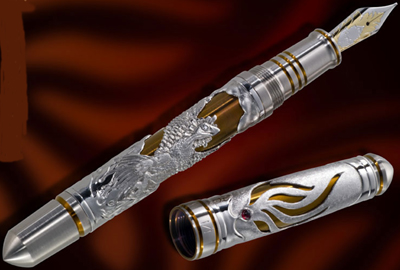 - GRAYSON TIGHE - "Distinctive Writing Instruments." Specializing in limited edition & one-of-a-kind collector and investment grade writing instruments.
 - GUÉPARD Geneve - since 1979. All models.
A
B
C
D
E
F
G
H
I
J
K
L
M
N
O
P
Q
R
S
T
U
V
W
X
Y
Z
- H -
 - HARLEY-DAVIDSON - since 1951. All ballpoint models.
 - HermÈs - Pencil in bougainvillea Madras goatskin.
 - HIGDON WRTING INSTRUMENTS - "Specializing in custom handmade pens made from fine and rare woods."
 - HYSEK - since 1997. All models.
A
B
C
D
E
F
G
H
I
J
K
L
M
N
O
P
Q
R
S
T
U
V
W
X
Y
Z
- I -
 - IXC:Pens by INOXCROM - since 1942. "The Writing Obsession." High-quality, aesthetically pleasing promotional items for companies. All collections.
A
B
C
D
E
F
G
H
I
J
K
L
M
N
O
P
Q
R
S
T
U
V
W
X
Y
Z
- J -
 - JAGUAR PEN - "Jaguar wordmark branded Ballpoint Pen. Choose from Black, Red or White."
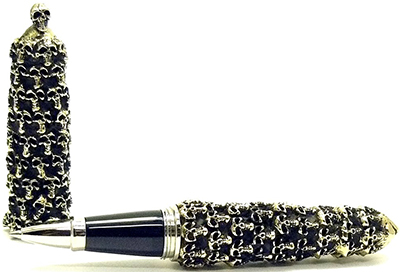 - JAC ZAGOORY - all models.
 - JEAN PIERRE LÉPINE - ballpoints, fountain pens & rollerballs.
 - Jorg Gray - since 1998. "Our writing instruments incorporate hand painted black lacquer finish over a brass case, high polished chrome accoutrements, and hand placed Swarovski elements."
 - Jot Script 2 EVERNOTE EDITION STYLUS - by Adonit. "The first true fine point stylus that allows your handwriting to flow as freely as your thoughts."
A
B
C
D
E
F
G
H
I
J
K
L
M
N
O
P
Q
R
S
T
U
V
W
X
Y
Z
- K -
 - Kaweco - "License to write since 1883." Ballpens, fountain pens, rollerballs, pencils, multifunction & calligraphy.
 - KORLOFF - since 1978.
 - KRONE - historical limited collections.
A
B
C
D
E
F
G
H
I
J
K
L
M
N
O
P
Q
R
S
T
U
V
W
X
Y
Z
- L -
 - La Marque - since 2019. "The Lifetime Brass Pen Collection." The refined brass pen & pencil collection. Made in Italy & created to accompany on your life journey.
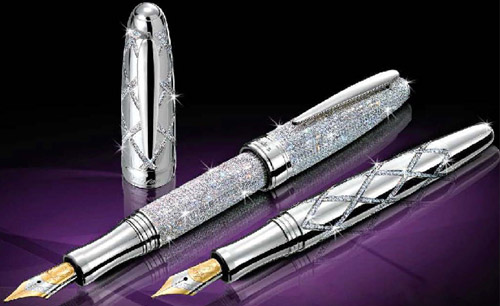 - LABAN - since 1981. "Refill your Soul by Writing." All models.
 - LALEX 1938 - all models.
 - LAMY - "Design. Made in Germany." Founded 1930. Writing instruments from Lamy stand out for their unmistakable design combined with top quality in functionality, material and finish. Writing enthusiasts all over the world also love them for their diversity: from around 25 design series and more than 200 models, everyone can find the perfect writing instrument - for every requirement and style. Ballpoint pens, Fontain pens, Multisystem pens, Propelling pencils & Rollerball pens.
 - Lamy Safari Fountain Pen - Black coated steel nib; fine point.
 - Lamy Unisex Lx Ruthenium Plated Fountain Pen - Designed by Wolfgang Fabian. Features a truly magnificent shape with an ergonomic grip for maximum comfort when writing. Its nib has been crafted from steel with black PVD for a suitable and smart finish.
 - LANCASTER - ballpoing & roller pens. All models.
 - Livescribe 3 Smartpen - "Never Miss A Word."
 - Livescribe Smartpens - "Never Miss A Word." All smartpens.
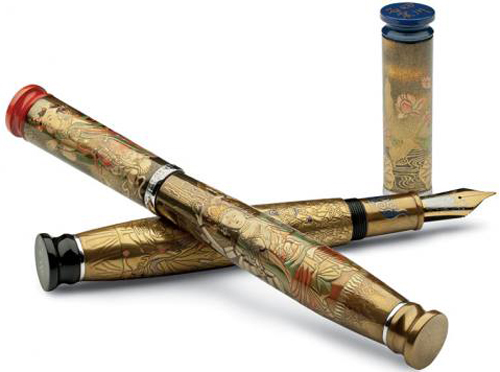  - Logitech Crayon - "Unleash your creativity on iPad. Grab a Crayon." Logitech Crayon is a versatile, pixel-precise digital pencil for iPad (6th generation) that allows you to unleash your creativity. Mark up PDFs, take handwritten notes, or doodle a masterpiece - Logitech Crayon works with apps that support Apple Pencil. And with hundreds of Apple Pencil supported apps available right now, you can start learning, collaborating, and creating on iPad instantly.
- LOIMINCHAY - since 1999. All collections.
 - LOUIS VUTTON - since 1854. All models.
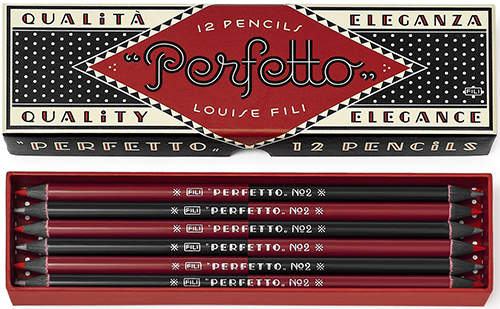 - Louise Fili - since 1989. "For a line of gift products produced by Princeton Architectural Press, Louise’s collection of vintage Italian pencil boxes inspired a set of double-sided, two-tone pencils, in a classic 1930s cursive."
A
B
C
D
E
F
G
H
I
J
K
L
M
N
O
P
Q
R
S
T
U
V
W
X
Y
Z
- M -
 - MARLEN PENS - since 1982. All collections.
 - Maserati Ballpoint Pens - all models.
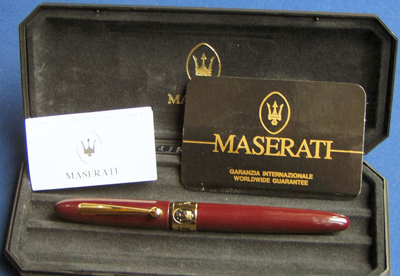 - Maserati fountain Pens - all models.
 - MERCEDES-BENZ PENS - all models.
 - Metaxas - since 1981. Rollerballs & Fountain Pens. All models.
 - MICHEL AUDIARD - all collections.
 - MICHEL PERCHIN PENS - all models.
 - MICKEY MOUSE - limited edition (1,928 pieces) sterling silver Mickey Mouse fountain pen.
 - MIIDORI - ebony & tulipwood pens.
 - MINIMALUX - brass ballpoint pen.
 - MOLESKINE - since 1997. Pens pencils.
 - MOLESKINE Smart Writing Set - "System made up of three objects – the special Paper Tablet notebook, the smart Pen+ and a companion App – that enable you to digitally edit and share what you create on paper in real-time without taking a photo, uploading files, or scanning documents."
 - MOMO DESIGN - since 1981. All models.
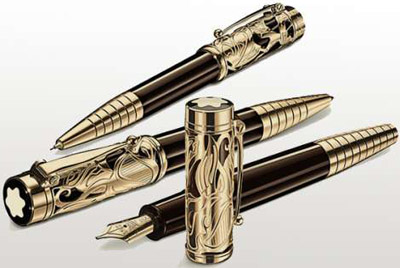 - MONTBLANC - founded 1906. "The Art of Writing." Discover our unique collections of writing instruments.
- 100 years of Montblanc's biggest icon: the MeisterstÜck - "This year, Montblanc is celebrating one-hundred-years of its most iconic creation, the Meisterstück range, a flagship line of pens so sought after, revered, and collected that it has become a piece of history in its own right."
- Montblanc commemorates 400 years since Shakespeare's death with a striking new pen - The Telegraph.
 - MONTEGRAPPA - founded 1912. All collections.
- MONTEGRAPPA - Extra Bespoke. Using ages-old technique and traditional tools, our craftsmen translate the customer’s chosen image into a pattern to be hand-engraved or hand-painted on both precious metal or resin, on the client’s behest.
- MONTEGRAPPA - Limited Editions.
- MONTEGRAPPA - Regular Editions.
- MONTEGRAPPA - Special Editions.
 - Monteverde - all collections.
 - Mouawad - since 1890. Rollerball pens.
A
B
C
D
E
F
G
H
I
J
K
L
M
N
O
P
Q
R
S
T
U
V
W
X
Y
Z
- N -
 - NAKAYA - since 1919. "Japanese handmade fountain pens." All collections.
 - NAMIKI - "The Fine Art of Expression." Most famous for their fountain pens with maki-e lacquering designs, are made in the Hiratsuka factory. 1928: Alfred Dunhill begins distributing the Namiki pen company’s maki-e lacquered pens. All collections.
- Napoleon-Souvenirs - "Coffret écrivain Empire."
A
B
C
D
E
F
G
H
I
J
K
L
M
N
O
P
Q
R
S
T
U
V
W
X
Y
Z
- O -
 - OMAS - founded 1925. All collections.
 - ONOTO - since 1905. "Since 1905, classic craftsman-made Onoto fountain pens have been cherished for their reliability, their innovation and their style in every corner of the world." All collections.
 - OrÉe Stylograph - "Pure copper ballpoint pen & refillable notebook to capture your notes & sketches on paper. Instantly share, edit & sync them via your smartphone."
A
B
C
D
E
F
G
H
I
J
K
L
M
N
O
P
Q
R
S
T
U
V
W
X
Y
Z
- P -
 - PARKER - founded 1888. All models.
 - Parker Jotter Pen, Stainless Steel, Medium Point, Black Ink
 - Amazon.com. - Amazon.com.
 - PATRICK PENS - by Loiminchay.
 - PAUL SMITH - Ballpoint pens & pencils.
 - PELIKAN - "Quality since 1938 - Made in Germany." All models.
 - Pentel Arts Sign Pen Touch - Fude Brush Tip, Black Ink, Box of 12. The richly saturated colors are fully blendable with water and other Sign Pen brush colors. Tip can be diluted with water to get a full range of values. Great for a variety of techniques, including feathering, Cross hatching, outlining, calligraphy and detailed line work. Wear-resistant, pressure sensitive, flexible tip. Will not dry out if left uncapped and can be cleaned with a paper towel.
 - Pentel R50 Rollerball Pen - Green Barrel Water-Based 0.8mm Tip 0.4mm Line Green Ref R50-D [Pack of 12].
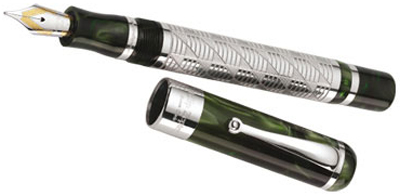 - PHILIP ZEPTER - all models.
 - PILOT - since 1918. "Power to the Pen!" All models.
- Pilot G2, the Greatest Pen on the Planet - "There are nicer pens and cheaper ones, too. But none are as noteworthy as Pilot’s retractable rollerball."
 - PINEIDER - "Firenze since 1774." All collections. Fountain pens, rollerball pens, ballpoint pens, lead pencils & personalized pencils.
 - Pinel + Pinel - "French Companies Pinel et Pinel and BIC are joining forces for a luxury collaboration featuring the iconic Cristal ballpoint pen. The iconic BIC brand is celebrating the 70th anniversary of its legendary Cristal pen. On this occasion the brand has opted for excellence by combining the pen’s original design with the luxurious know-how and craftsmanship of Maison Pinel et Pinel. The Cristal pen is bedecked with leather made in the Pinel et Pinel Paris workshop. The pen has a nickel- or gold-plated metal cap."
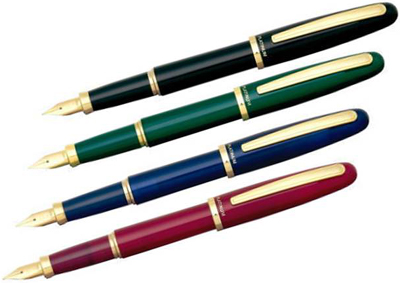 - PLATINUM PEN USA - since 1919. All models.
 - PORSCHE DESIGN - since 1972. All ballpoint pens, fountain pens, rollerball pens & pencils.
 - PULSE SMARTPEN - by Livescribe. Ballpoint pen, computer, and audio recorder manufactured by Livescribe that "records what you hear and write so you never miss a word."
A
B
C
D
E
F
G
H
I
J
K
L
M
N
O
P
Q
R
S
T
U
V
W
X
Y
Z
- R -
 - RAYMOND WEIL - founded in 1976.
 - RETRO 51 - fine writing instruments.
 - Richard Mille RMS05 - since 2001. "Quintessential Writing Instrument." Price: US$105,000 mechanical fountain pen. The fountain pen is a symbolic luxury object designed to appeal to the daily or occasional user, the simply curious, the connoisseur and the collector alike. Locked for centuries in an endless cycle of popular or stylistic reinterpretations, it has rediscovered its true worth with Richard Mille. We have revolutionised this quintessential writing instrument, transforming it into a pure product of watchmaking by virtue of a mechanical movement as complex as any RM calibre.
The last word in cutting-edge technology and innovation, with a strong artistic angle and optimally ergonomic design, the mechanical fountain pen epitomises the brand’s entire philosophy. The pen is equipped with a genuine, manufactured calibre, thus fitting perfectly with the Swiss Jura watchmaker’s development and production strategy. It offers those in the know a product that captures the essence of Richard Mille, in the same way as the mechanical titanium cufflinks did.
Developed by the brand’s movement creators, the pen took almost four years to research and develop before emerging as an exceptional, highly technological, one-of-a-kind product.
 - Riind - "The Pen. Rewritten." Introducing The Pen that rewrites them all.
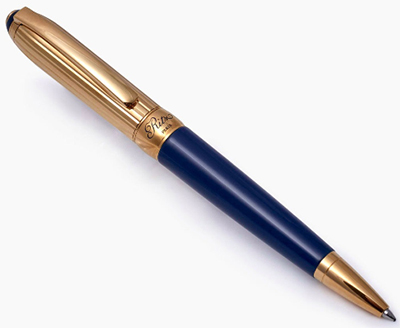 - Ritz Paris Essentials - Ball Pen.
 - ROBERTO COIN - since 1977.
 - ROLLS-ROYCE PHANTOM LIMITED EDITION PEN SET - by Conway Stewart. Only 25 sets made.
 - ROTRING - founded 1928. "Looking for the perfect creative tool?" All models.
A
B
C
D
E
F
G
H
I
J
K
L
M
N
O
P
Q
R
S
T
U
V
W
X
Y
Z
- S -
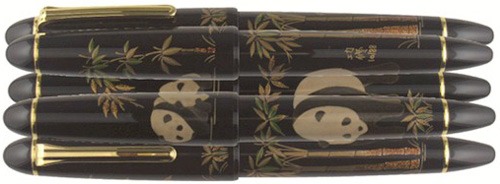 - SAILOR - "Spirit Of Japan." All collections.

- SAINT HONORÉ PARIS - since 1885. Ball pens & personalized pens. All collections.
 - SAKURA OF AMERICA - all collections.
 - SCHROEDER - since 1877. Luxury rollerball pens.
 - SENSA - "The World's Most Comfortable Pen." All collections.
 - Sharpie - markers & pens.

- SHEAFFER - founded 1912. "Premium writing tools." Ballpoint pens, rollerball pens & fountain pens.
 - Smith & Wesson SWPEN3BK Tactical Pen with Stylus Tip
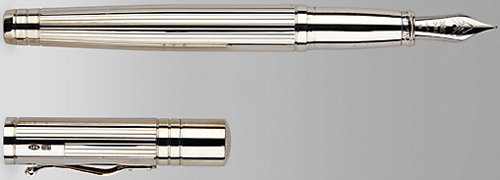
- SMYTHSON OF BOND STREET - since 1887. "Each silver fountain pen, silver ball point pen or solid silver pencil comes with its own unique serial number and lifetime guarantee."
 - Sprout - since 2012. "Plant Your Pencil." Being a sustainable pencil, Sprout is often nominated for various awards, and quite often actually wins!
- S.T. DUPONT - since 1871. "Take pleasure in the art of putting pen to paper. Words that take shape in your mind are brought to life on the page, gracefully, smoothly with the reassuring weight of a handcrafted writing instrument, as expressive as you are." All collections.
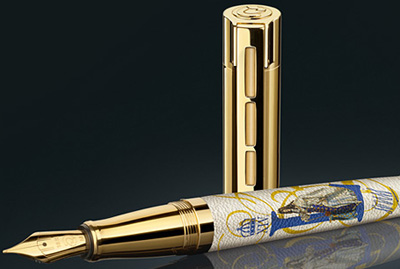 - STAEDTLER Premium - founded 1835. All collections.
 - STEFANO RICCI - fountain pen.
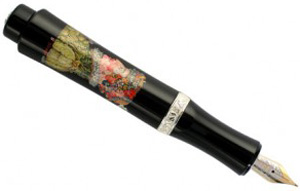
- STIPULA - since 1973. All models.
- Submarine Collection: THIS FOUNTAIN PEN MAKES CREATION FLOW ON THE WRITING SURFACE, COMES WITH TURBO INK FILLING MECHANISM - "If you also love keeping a fountain pen handy, the Submarine Collection by TaG will interest you. The submarine-shaped fountain pen edition is developed in collaboration with Hou Xin-Yong, a highly experienced calligrapher with over 2 decades of expertise, and Lee Tai-Ying, the founder of a fountain pen club in Taiwan."
 - SWAROVSKI - founded in 1895. Ballpoint pens, rollerballs & stylus pens. All collections.
A
B
C
D
E
F
G
H
I
J
K
L
M
N
O
P
Q
R
S
T
U
V
W
X
Y
Z
- T -
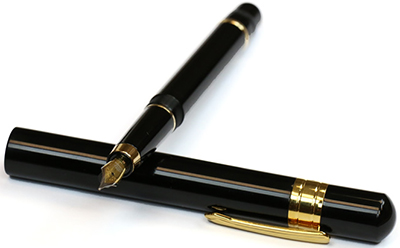
- Taccia - "A relatively recent arrival in the world of fountain pens, Taccia was founded in 2003 by fashion designer Shu-Jen Lin. Distinctive and unusual designs, often utilizing materials not often used in pen production, have become a hallmark of the Taccia brand. For the pen enthusiast seeking an excellent writing instrument with a twist of the unusual, Taccia will often be the choice."

- TATEOSSIAN London - since 1990. All collections.

- Ti Arto - "The Ultimate Refill Friendly Pen." A timeless solid titanium pen that accepts over 200+ refills w/o any modifications, hacks, or tip wiggle.
 - TIBALDI - since 1916. All collections.
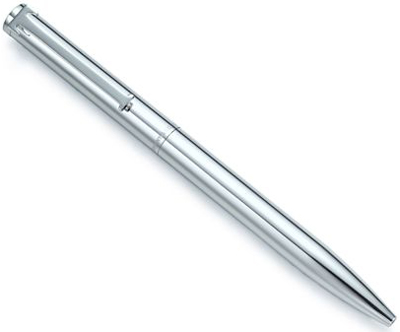
- TIFFANY & CO. - since 1837. All collections.

- TOKENS & ICONS - since 1991. All models.
A
B
C
D
E
F
G
H
I
J
K
L
M
N
O
P
Q
R
S
T
U
V
W
X
Y
Z
- U -

- Ugmonk - "Ugmonk was founded by designer Jeff Sheldon in 2008 with a mission is to produce well-designed objects with a minimal aesthetic." Pens.

- ULYSSE-NARDIN - since 1846. Visconti fountain pen.

- UNDERWOOD - all collections.

- Uni-ball Jetstream is the best pen for everyday writing - The Wirecutter.
- UNI-BALL - since 1887. "Performance and Design." Mission: To design the world's best writing instruments: inside and out. All performance. All design. uni-ball pens are an upgrade the moment pen hits paper. All models.
- best pen 2023 - "The Uni-ball Jetstream RT, a ballpoint pen for everyday writing. After evaluating 26 contenders and conducting three rounds of testing, our experts found one clear winner."
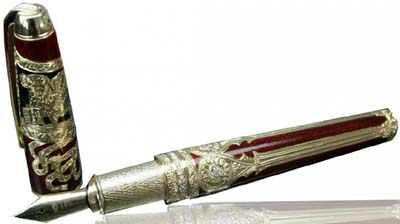
- URSO - since 1985. Handmade luxury fountain pens. Materials: 18kt solid gold, enamel, diamonds.
A
B
C
D
E
F
G
H
I
J
K
L
M
N
O
P
Q
R
S
T
U
V
W
X
Y
Z
- V -

- VERSACE - all collections.

- VERTU - since 1998. Classic ballpoint pen & pencil.

- VISCONTI - since 1988. "Selected for such history-making events as signing the NATO-Russia Summit on May 28, 2002, which marked the end of the cold war." All collections.
A
B
C
D
E
F
G
H
I
J
K
L
M
N
O
P
Q
R
S
T
U
V
W
X
Y
Z
- W -
 - WAHL-EVERSHARP - "Dromgooles Fine Writing Instruments." Ballpoints, finewriters, fountain pens, pencils & roller balls.

- WATERFORD - originally founded in 1783. Pens & fountain pens.

- WATERMAN of Paris - "Skilfully made in France, every Waterman pen creatively echoes the genius of our founder Lewis Edson Waterman, inventor of the first reliable fountain pen in 1883." All collections.

- Webson Gill - "One Pen, A Million Memories." Move over ballpoint, there is a new kid on the block.

- WEDGWOOD - "Quintessentially an English company established in 1759 a variety of luxury writing instruments." All collections.

- WILLIAM & SON - since 1999. All collections.
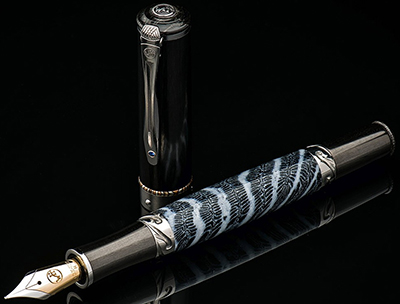
- WILLIAM HENRY - "Executive Luxury Pens & Writing Instruments." All models.
A
B
C
D
E
F
G
H
I
J
K
L
M
N
O
P
Q
R
S
T
U
V
W
X
Y
Z
- X -

- XEZO - "Time Evolves." All models.
A
B
C
D
E
F
G
H
I
J
K
L
M
N
O
P
Q
R
S
T
U
V
W
X
Y
Z
- Y -

- YARD-O-LED - Handcrafted in England since 1934. "Luxury Silver Victorian Fountain Pens." All collections.
A
B
C
D
E
F
G
H
I
J
K
L
M
N
O
P
Q
R
S
T
U
V
W
X
Y
Z
- Z -
 - ZINO DAVIDOFF - all collections.

- ZIPPO - Burgundy Leather Wrap Ballpoint Zippo Pen.
|
|

